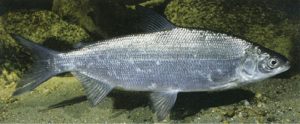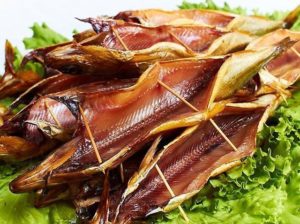Have Cisco the mouth end, the axis of the body passes through the middle of the eye, the lower jaw does not go over the top, usually of the jaw of equal length. The coloration of the back varies from brown to green, flanks silvery.
Clearly expressed differences between males and females, not only during spawning, males have a more pronounced epithelial tubercles.
In Baikal omul penetrated from the Arctic ocean via the river system about 20 thousand years ago, i.e. during the last glaciation. As a result of adaptations to environmental conditions in the lake, he formed the intraspecific forms, which differ in several morphological characteristics and features of the environment. Currently in lake Baikal there are three groups the chance to catch Arctic Cisco with ecological and morphological differences: pelagic (Selenge), coastal (Barguzin and Severobaikalsk), benthos-deep (Embassy, Chivyrkuisky and other populations reproducing in small rivers). The basis of each group are populations that differ by habitat, time and places (different by the length of the Baikal tributaries) of spawning.
Arctic Cisco live to 16-20 years (Lena), but most catches are dominated by individuals of 10-11 years. Usually the size of Mature fish 26-40 cm and weight about 1 kg., there are individuals up to 64 cm long and weighing 2-3 kg., and in the Indigirka – to 5.2 kg. Baikal omul smaller, but also here before there were individuals weighing 7-10 kg.
Cisco is a catadromous fish. Arctic Cisco from the rivers out to the feeding grounds in the sea, using not only the bays and inlets, but also the entire coastal zone of polar seas. Of all white fish the omul is the most Northern regions can withstand salinity up to 20-22, occasionally enters the water with a higher salinity, in the period of summer foraging occurs in the Kara sea and reach the new Siberian Islands.



In the largest inflow of Baikal – the Selenga spawns pelagic omul (mnogorazemny), which has a cigar-shaped body, large eyes, narrow caudal fin, often sitting on the Gill arch stamens (44-55). He lives in the pelagic zone of lake Baikal, during spawning, ascends the river up to 1600 km, and is Powered by living in the water column organisms: zooplankton, macrohectopus, pelagic Bykovym and their larvae. It winters at a depth of 200-300 meters.
In medium-length coastal rivers to spawn omul (srednetagelaya). Fish has a long head, high body and host fin, rarely sitting Gill stamens 40-48. It feeds in the coastal zone of Baikal for spawning comes into the rivers Upper Angara (640 km), Kichera (150 km), and Barguzin (400 km). Feeds on zooplankton (23%), medium-sized macrohectopus (34%), pelagic gobies (26%) and other objects (17%).
Benthic-deep-water omul (melodically) inhabits lake Baikal at a depth of 350 m is Characterized by the greatest height of the body and caudal fin, a long head, a small number (36-44) rough and long Gill rakers. It spawns in small tributaries of lake Baikal with a length of spawning the way from 3-5 km (Bezymyanka and R. R. Maly chivurkuy) to 20-30 km (the river Great Chivyrkuy and R. Bolshaya Rechka). Food is dominated by macrohectopus medium size (52%), fish (25%), benthic gammarids (12%) and zooplankton (10%). The Posolsky omul 1933 artificially bred at the Bolsherechensky fish factory.
Arctic Cisco in the sea feeds on large crustaceans – shrimps, mysidae, juvenile gobies, fry of whitefish. Getting to places with a high concentration of plankton, fish transfers to the diet of planktonic crustaceans. Baikal omul feeds on zooplankton, shrimps and fish fry.
Arctic Cisco become Mature at the age 6-8 years old when it reaches the length of 35 cm On spawning rises in the rivers, sometimes for quite long distances (up to 1500 km). During spawning, the fish does not eat and loses weight. Spawning happens in October, noted the admissions of spawning, so for the life the female has time to spawn only 2-3 times. Fertility is equal 16-60, an average of 20-30 thousand eggs. Flock spawning presents individuals from 4 to 13 years (the Pechora). After spawning omul sinking into the sea.
Baikal omul it Matures in the fifth year of life at a length of 27-28 cm, a flock spawning presents individuals aged 4 to 9 years. In rivers Ambassadorial litter (Large, Kultushnaya, Abramikha) for reproduction comes in two shoals in September and October, at a water temperature of 10-13°C and 3-4°C respectively. It spawns on stony pebbly soil, with a rapid current. Spawning usually occurs in the evening and night hours. Spawned Cisco rolls down to the lake.
The fecundity of Arctic Cisco from 4 to 40 thousand eggs, the size of the calves 2-2,5 mm. Eggs attached to the ground, and at water temperatures of 0.2-2°C. the Embryogenesis lasts an average of 190-200 days. Larvae length of 10-12. 5 mm. and a weight of 6-7 mg. appear in late April – early may, at a water temperature of from 0.2 to 6.5°C. the Hatched larvae over water demolition in the Embassy COP where they grow and eat. Eating prey, the larvae make throws from a distance of 3-5 mm. up To the age of 30 days they intensively feed on planktonic organisms, and their food consists of more than 55 species of invertebrates belonging to 15 different groups.
In Russia, the Arctic omul inhabits all the Northern rivers from Mezen in the West to Chaunskaya Bay in the East, also Obi, is, in the Penzhina, also inhabits the Arctic coast of North America from Cape barrow to the Gulf Cornelsen. This catadromous species. Baikal omul lives only in lake Baikal, rising to spawn in the river. Baikal omul introduced to Mongolia in 1956-1957., where he now lives permanently (oz.Hovsgol and influent rivers). Bred omul in the European part of Russia and in some foreign countries, but self-reproducing populations nowhere.
Cisco – famous Delicatessens hero songs, in our submission associated with Baikal, although most of it is produced in rivers from Veltae (to the West of the Pechora river) to Alaska and Northern Canada. This large fish is a target species in all Siberian rivers, except the Ob, which for some reason he does not go, though there is in the Gulf of Ob. There are summer (June-July) and autumn course omul.
Baikal omul is the object of fishing in Baikal. In 1969, scientists noted a significant reduction in the number of fish, and therefore fishing was prohibited. Thanks to a variety of environmental activities by 1979, its population was restored and the ban was abolished. Currently, the population is being drastically reduced because of active fishing. The population of the Baikal omul for many years are in a state of depression. Catches and population of the Baikal omul in recent years, are plummeting. Introduction of restrictions on his catch until does not improve the situation.


